Parts and Components Makers Show Latest Offerings at 2011 Motorcycle Taiwan & EV Taiwan
2011/09/15 | By Quincy LiangSome 235 exhibitors joined the 2011 Taiwan International Motorcycle Industry Show (Motorcycle Taiwan) and 2011 Taiwan Int'l Electric Vehicle Show (EV Taiwan), which were held April 14-17. Most were makers of parts and accessories for powered two-wheelers (PTWs) and electric vehicles (EVs).
Strenuous efforts by makers of parts and accessories have contributed to the rapid development of Taiwan's PTW industry, and suppliers of key parts and systems are playing an ever-more-important role in upgrading the global competitiveness of the island's emerging EV industry.
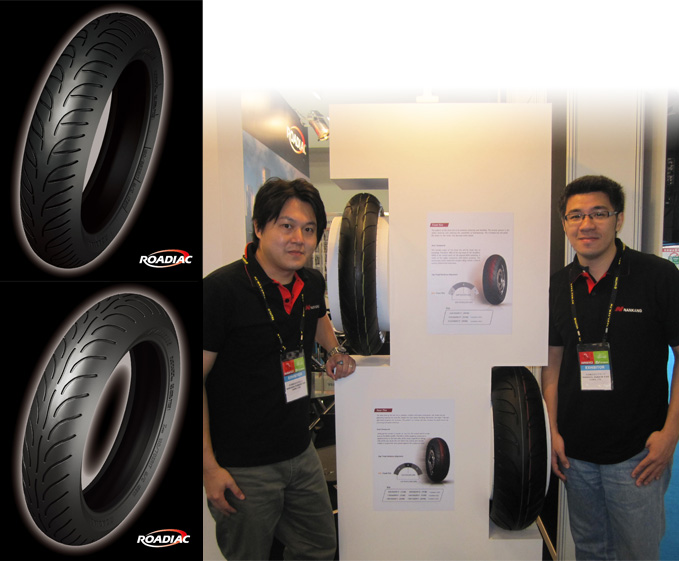
A Better Tire for Sport Touring Bikes
One example of this support is provided by the Nankang Rubber Tire Corp., which used the recent show to introduce its first-ever high-end motorcycle tire, the radial Roadiac, to the growing sport touring-bike market.
According to the company, the Roadiac has been tested on complex test tracks specially designed to evaluate all aspects of steering, stability, and handling performance on dry and slippery surfaces.
Keith Juan, who is responsible for Nankang's tire exports, reported that the Roadiac uses the firm's advanced JLSB (Jointless Space Belt) technology to provide better stability, handling, stiffness, and heat-dissipation. Roadiac is also less likely to be punctured, and so is much safer than other tires.
Different tires have been developed for front and rear use. The tread pattern of the front tire is designed to enhance cornering and handling, with a central groove for better draining and a reduced potential for hydroplaning or slipping on wet roads. V-shaped lugs guide water to the center and decrease water splash, Juan added.
The main requirements of rear tires are stability, comfort, and endurance, and the center ribs of the Roadiac not only improve comfort but also provide more stable handling. A wide tread width effectively increases tire life, and the pattern on the two wings of the tire improves cornering and water-draining performance.
The front Roadiac tire is available in 120/70ZR17 (58W), while the rear tire is offered in 180/55ZR17 (73W), 170/60ZR17 (72W), and 160/60ZR17 (69W). More options will be added this year, the company said.
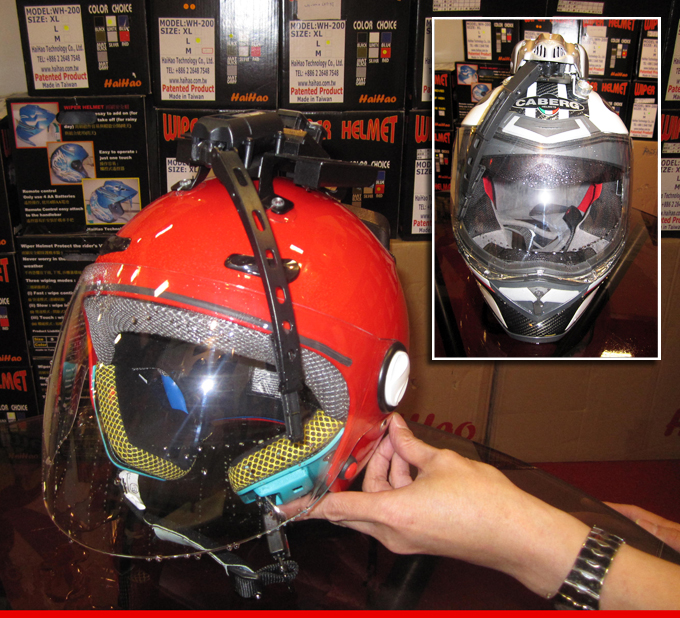
Helmet Wipers
The young and innovative HaiHao Technology Co. has been striving to improve safety for powered two-wheeler (PTW) riders worldwide, and has discovered that the most effective way to do this is to use helmet wipers to provide a clear view.
In the past two years the company has developed a series of touch-control wiper helmet models with a sophisticated miniature electrical wiper system. Basically, the touch-control wiper helmet features a single-arm automotive wiper system on a motorcycle helmet, requiring the electronic control, wiper mechanism, and power supply to all fit inside a very small space.
Jerry Tseng, HaiHao's general manager, has been working to improve his wiper helmet for six years. The first-generation wiper called for the user to control the wiper by mouth, and the second-generation required the shield to be custom-made to fit the wiping angle. The third generation was a modularized system, but it still had to be customized for specific helmet models.
The latest version is a patented universal-type wiper system for motorcycle helmets that can be mounted on about 95% of all helmets currently available in the market, whether full- or open-face. The installation of the system is very easy--just affix it to the top of a helmet with its suction discs, which have a special built-in mechanism to prevent loosening. The system can be installed in three minutes and removed in just one minute.
Both the device and the wiper arm have adjustable mechanisms to fit the helmet body and the visor to provide a clear view to PTW riders on rainy, dusty, or snowy days.
HaiHao has also developed many other innovative safety devices for PTW riders. For example, the firm has introduced an active ventilation and anti-fog device that pumps a constant stream of fresh air into a helmet to keep the visor, and the rider's eyeglasses, dry and clear. The device uses four AAA batteries and has a fan-speed adjustment plus a power switch. The device has to be customized for targeted helmet models.
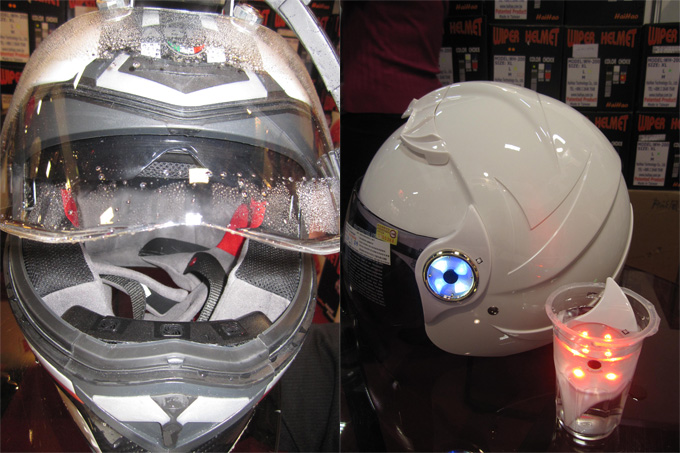
Another innovation is an LED accessory that can replace a helmet's original visor-changing buttons. The high-brightness LED side marker is 100% waterproof and is plated to offer safety as well as a good tactile feel for riders.
Jerry Tseng is proud of his third-generation helmet wiper's development into an advanced, modularized product, an innovative, miniaturized wiper system customizable to fit virtually every full-face safety helmet.
STOBA-Technology Lithium-ion Power Cells
Amita Technologies Inc., a major manufacturer of lithium polymer batteries for EV applications, showcased Taiwan's first mass-produced LiCoxNiyMnz power cells incorporating patented STOBA (Self Terminated Oligomers with hyper-Branched Architecture) technology. One of the products on show was the company's latest 3.7V 20Ah STOBA LiCoxNiyMnz 85200145 cell, which was developed to meet the demand from electric-vehicle manufacturers.
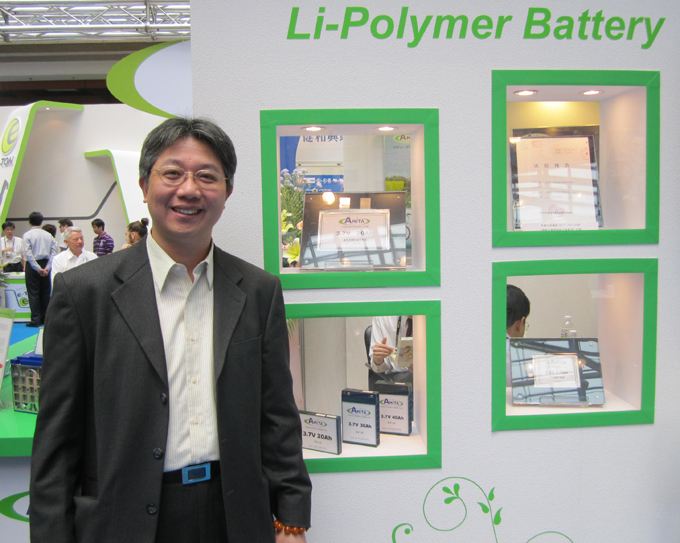
James Peng, director of Amita's R&D department, explained that STOBA is a nano-grade high-molecular material that is integrated into lithium batteries to automatically form a protective film. When a lithium battery is overly heated, impacted, or pierced, the STOBA immediately stops electro-chemical reactions to prevent short-circuiting that can generate excessive heat and the risk of fire. This makes STOBA lithium batteries much safer for 3C (computers, communications, and consumer electronics) products and electrical vehicles (EV). STOBA technology offers the only effective method of overcoming the safety issue with lithium batteries.
Peng claimed that Amita has turned out tens of thousands of STOBA lithium-polymer cells, which have been approved under the QC/T 743-2006 national standard in China. The company has supplied its lithium batteries to some light electric vehicle (LEV) makers in Taiwan, and plans to tap into electric-car supply chains in the future.
World's 1st Four-function Racing Shock Absorber
The Taiwan Chengfeng Industry Co., which markets its high-end performance shock absorbers globally under the "FastACE" brand, unveiled its patented product, the world's first four-function adjustable shock absorber for PTWs, at the show.
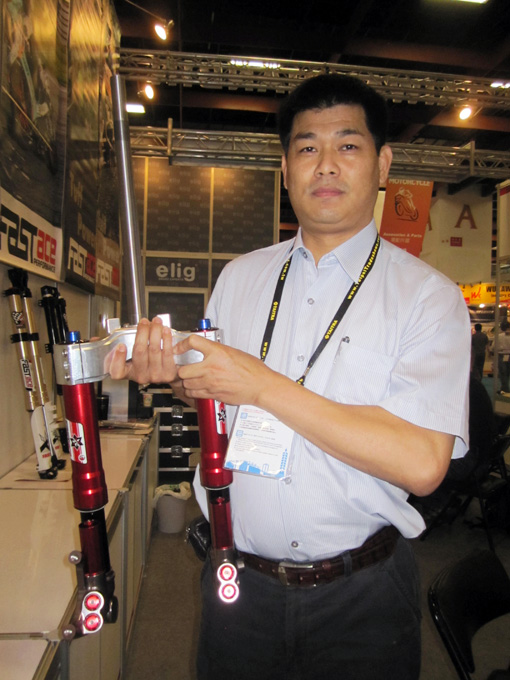
Lee Chung-jia, the firm's president, noted that his advanced shocks have four adjustable functions: rebound damping (12 stages), high-speed compression (18 stages), lower-speed compression (18 stages), and spring pre-load (or course rebound, 10mm). All of the adjustment buttons are located at the shock's front side, Lee added, making adjustment easy for users.
The president said that Chengfeng is Taiwan's largest and most comprehensive developer and producer of high-end PTW performance shock absorbers, with a domestic workforce of more than 60 people, including over 10 R&D staff, as well as a modern and integrated facility in China which employs more than 200 people.
Chengfeng started out by making shocks for scooters and has gradually expanded its product line to include other motorcycle applications. Lee says that the company sponsors PTW racers with its high-end products and, in this way, accumulates data and know-how to improve product quality and performance. Each shock produced by Chengfeng is carefully tested and inspected before packaging, he stressed, and each item has its own ID number, representing the firm's responsibility for product quality.
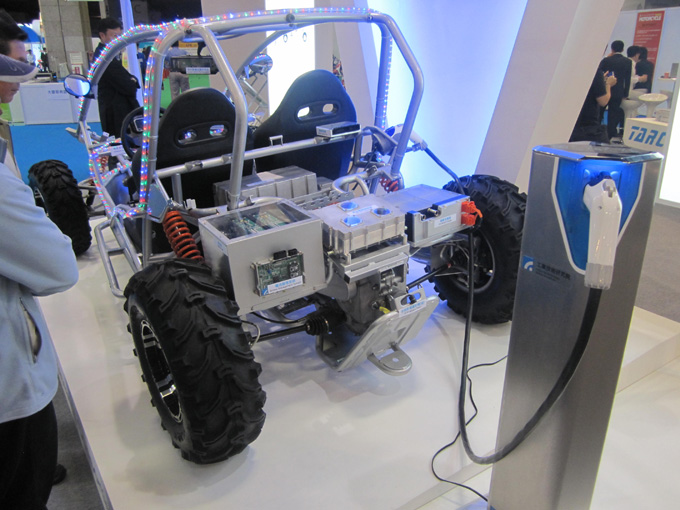
TARC Pavilion: EV and LEV Achievements
The Taiwan Automotive Research Consortium (TARC) was set up in 2005 by four founding members: the Mechanical and System Research Laboratories (MSL) of the Industrial Technology Research Institute (ITRI), the Automotive Research and Testing Center (ARTC), the Chung-Shan Institute of Science and Technology (CSIST), and the Metal Industries Research and Development Center (MIRDC), along with about 120 private suppliers and manufacturers.
Among the consortiums goals are helping local vehicle-parts suppliers to upgrade their international competitiveness, bring the island's advantages into full play, and create new business opportunities so that Taiwan can move toward becoming an R&D and key-parts supply center for global intelligent and electrical vehicle makers. At the two shows, TARC operated a pavilion to exhibiting R&D achievements for EVs and LEVs.
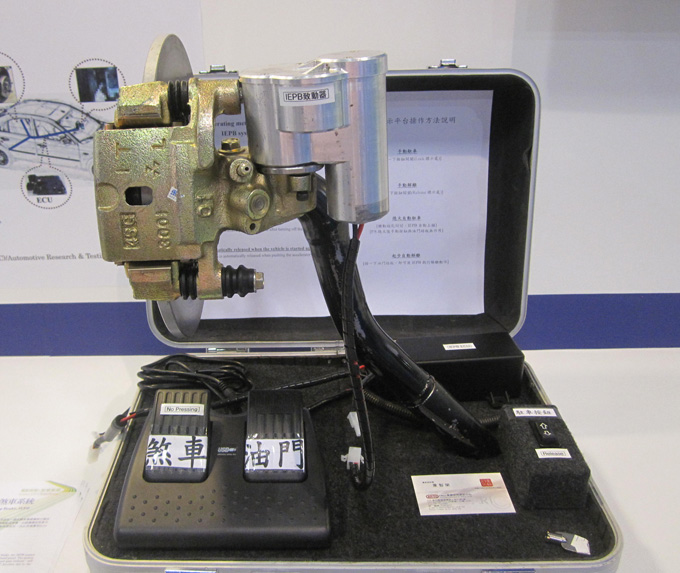
In its pavilion, TARC displayed an electric vehicle platform that incorporated most of its EV-related R&D achievements, including a vehicle control unit, permanent-magnetic traction motor, motor controller, battery management system (BMS), STOBA battery pack, on-board charger, DC-DC converter, AC charger, DC charger, and around-view monitoring (AVM) system.
The EV motor controller on show had a maximum power of 50KW and up to 92% efficiency control with an extended speed range up to 8,000 revolutions per minute (RPM) for maximum constant power. The display also included a brake regeneration control. The controller featured dual-mode control with high torque at low speed and high efficiency at high speed, as well as diagnostic techniques for the whole electrical propulsion system.
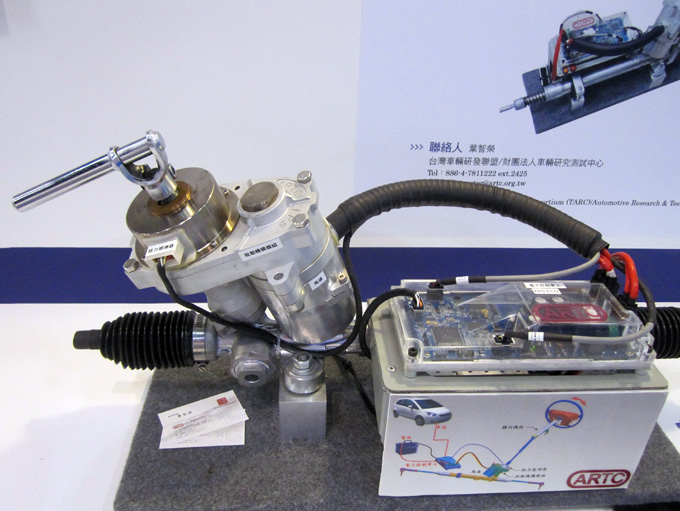
The high power induction motor driver, or HPIMD, developed by CSIST, can be applied to EV power systems. The controller operates with a Field Oriented Control (FOC) algorithm, allowing a vehicle to achieve optimal performance in different driving modes with different speeds and loads.
ITRI's EV charging system features an unmanned charging-management system with remote monitoring, diagnosis, and control functions. The system also has intelligent power management (power demand control functions for charger network, security and safety protection), user identification, a security mechanism for plugs and sockets as well as charging status monitor, and a compact, efficient DC charger-resonance circuit and high-frequency isolation for the DC-DC stage.
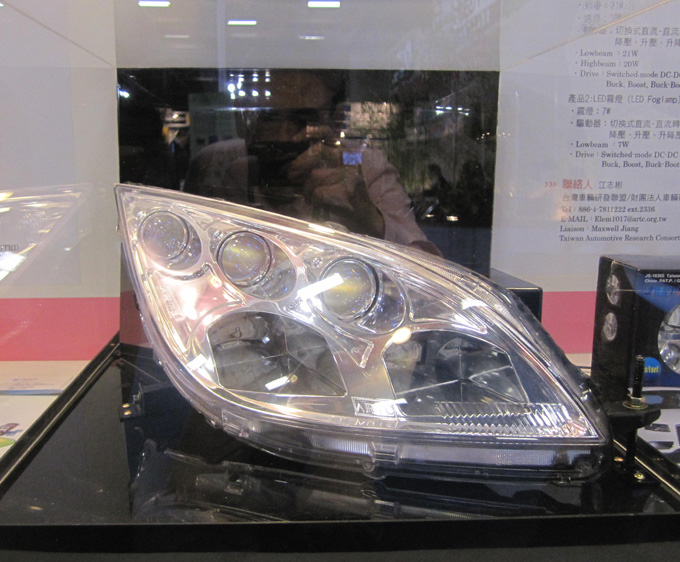
The integrated electric parking brake (IEPB) developed by ARTC sets the parking brake at the push of a button; the system consists of a control unit and an electric motor which actuates the combined gear reducer, self-locking components, and brake calipers. An automatic electric air-conditioning system developed by ARTC is driven by an electric motor instead of a traditional internal combustion engine, significantly reducing engine exhaust pollution; it can also be adapted for battery electric vehicles. The system is controlled by a variable-frequency motor controller and thermostat controller, so it can provide the needed effect according to the preset temperature, state of charge of the EV's battery system, and other environmental parameters.
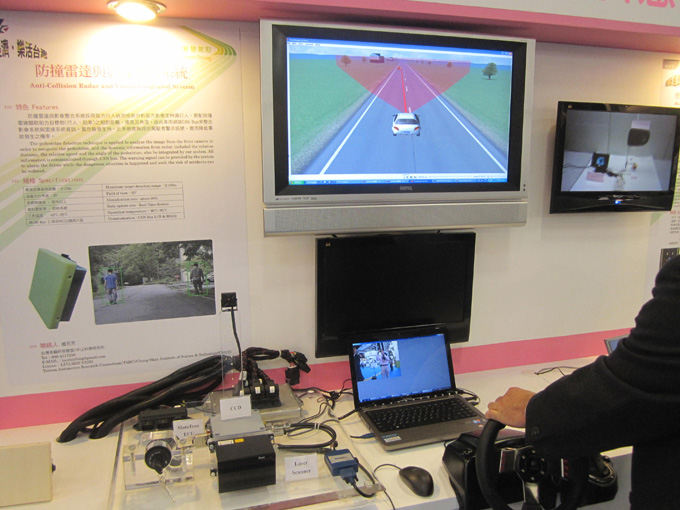
Using its defense technology, CSIST developed the vehicle's anti-collision radar and vision integrated system. Pedestrian detection technology is applied to analyze the image from the front camera, and dynamic information from the radar, including distance, relative speed, and angle of pedestrians, is also integrated into the anti-collision system. All information is communicated through a CAN-bus, and the system provides warning signals to alert the driver.
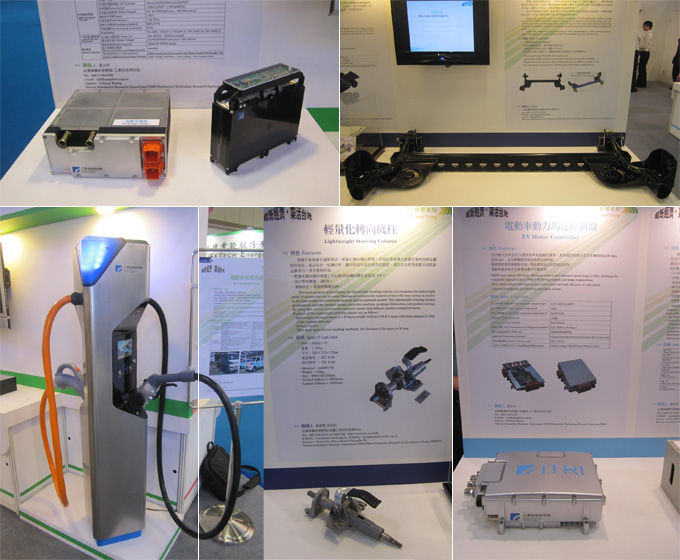
ARTC showed off an LED headlamp, using three 7W LEDs for low beam and two 10W LEDs for high beam, which it said is ready for commercialization. Compared with other headlamps, the LED model offers the advantages of faster response, longer life, lower power consumption, and better design flexibility. ARTC's Automotive Optic Design Center can help lamp manufacturers establish LED optical design, thermal design, and electronic design capabilities, and go on to develop LED lamp products.




